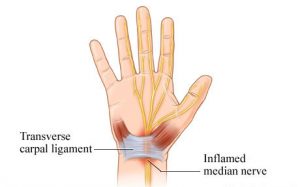Carpal tunnel. No, it’s not a ride at Disneyland! Carpal tunnel syndrome is a wrist injury typically found in those that have jobs involving repetitive wrist movements, such as designers, painters, hairdressers or cashiers. For that reason, it’s often referred to as an RSI (repetitive stress injury) commonly found in the occupational workforce. It’s painful and often affects mobility – but there is a light at the end of the tunnel (see what we did there?)
Keep reading to find out more about diagnosing and treating carpal tunnel syndrome.

What is Carpal Tunnel Syndrome?
Carpal tunnel syndrome (CTS) is the result of the median nerve being compressed where it passes through the wrist’s carpal tunnel. The carpal tunnel itself is a narrow passageway surrounded by bones and ligaments on the palm side of your hand.
The median nerve runs from your forearm through the carpal tunnel and to your hand. The nerves primary purpose is to provide feeling to the palm side of your thumb and fingers. It also provides the motor function for the muscles around the base of your thumb. When the median nerve is compressed, you’ll often experience numbness, tingling and weakness in the hand and the wrist.
Causes of Carpal Tunnel Syndrome
As mentioned above, Carpal Tunnel Syndrome is caused by the compression of the median nerve. Any compression of the median nerve in the carpal tunnel may lead to carpal tunnel syndrome. The most common causes of compression are a wrist fracture or swelling and inflammation caused by rheumatoid arthritis.
Some of the factors that cause Carpal Tunnel Syndrome are
- Arthritis – most commonly rheumatoid arthritis
- Pregnancy – increased fluid retention can compress the median nerve
- Congenital factors – the varying size of carpal tunnels
- Overuse of wrist
- Rapid weight gain
Signs and Symptoms of Carpal Tunnel Syndrome
Along with any tingling and tightening, if you’re suffering from carpal tunnel syndrome, symptoms you may experience include:
- Pain in the wrist and fingers
- Stiffness in wrist or fingers
- Numbness
- Pins and needles
- Shooting pains from the wrist
- Pain radiating into the arm and shoulder
- Loss of strength in the hand
Treatment for Carpal Tunnel Syndrome
Treatment for carpal tunnel syndrome should commence as soon as you notice symptoms. Early treatment may be as simple as rest, applying ice, and taking precautions to avoid activities that increase the severity of your symptoms.
Our physiotherapists offer a range of treatment methods and strengthening exercises for carpal tunnel that can help to reduce symptoms or rehabilitate the injury. Addressing your worksite and postural elements, is also paramount to recovery, as well as education to prevent the chance of re-injury.
If these methods and other non-surgical treatments such as wearing a carpal tunnel splint provide little to no improvement and you have a more severe diagnosis, then a surgical route may be pursued.
Depending on the severity of your carpal tunnel symptoms a doctor may recommend you receive an endoscopic or open surgery on your carpal tunnel. The primary goal of both types of surgery is to reduce the ligament putting pressure on the median nerve. After the surgery, your ligament tissue will eventually grow back allowing for more room for the median nerve.
Carpal Tunnel Syndrome Prognosis
If you start treatment early, a gradual reduction in symptoms over a 6-8 week period with appropriate management and activity modification is typical. If you have received surgery, you may feel a prolonged numbness in the fingers and or wrist, but this is likely to subside. If not treated, carpal tunnel syndrome can lead to permanent nerve damage.
If you think you might be suffering from carpal tunnel syndrome, book in for treatment now with one of our exercise, physio, or pain specialists via 1300 012 273 or book a session online at your nearest clinic.

